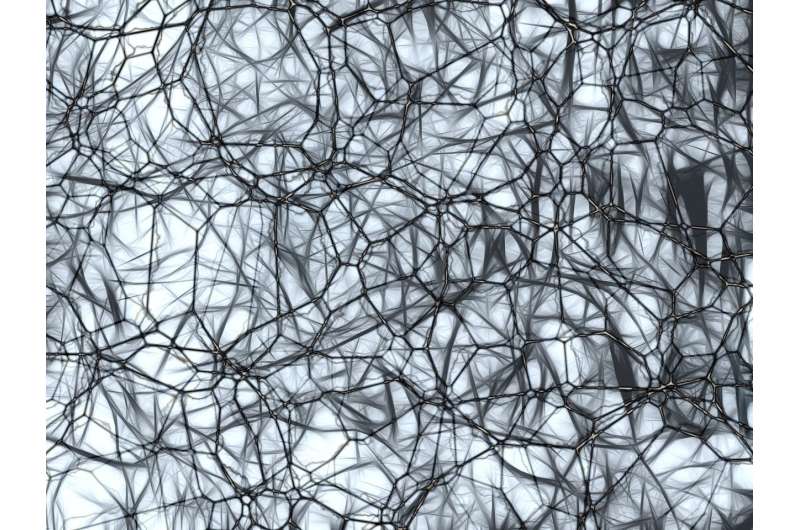 Credit: CC0 Public Domain
Credit: CC0 Public Domain
Scientists have identified an unusual type of brain cell that may play a vital role in progressive multiple sclerosis (MS), likely contributing to the persistent inflammation characteristic of the disease.
The discovery, reported today in Neuron, is a significant step toward understanding the complex mechanisms that drive the disease and provides a promising new avenue for research into more effective therapies for this debilitating condition.
MS is a chronic disease in which the immune system mistakenly attacks the brain and spinal cord, disrupting communication between the brain and the body…
 Credit: CC0 Public Domain
Credit: CC0 Public Domain
Scientists have identified an unusual type of brain cell that may play a vital role in progressive multiple sclerosis (MS), likely contributing to the persistent inflammation characteristic of the disease.
The discovery, reported today in Neuron, is a significant step toward understanding the complex mechanisms that drive the disease and provides a promising new avenue for research into more effective therapies for this debilitating condition.
MS is a chronic disease in which the immune system mistakenly attacks the brain and spinal cord, disrupting communication between the brain and the body. While many individuals initially experience relapses and remissions, a significant proportion transition to progressive MS, a phase marked by a steady decline in neurological function with limited treatment options.
To model what is happening in the disease, researchers at the University of Cambridge, UK, and National Institute on Aging, US, took skin cells from patients with progressive MS and reprogrammed them into induced neural stem cells (iNSCs), an immature type of cell capable of dividing and differentiating into various types of brain cells.
Using this “disease in a dish” approach, the team observed that a subset of the cultured brain cells was somehow reverting to an earlier developmental stage, transforming into an unusual cell type known as radial glia-like (RG-like) cells. Notably, these cells were highly specific and appeared approximately six times more frequently in iNSC lines derived from individuals with progressive MS compared to controls. As a result, they were designated as disease-associated RG-like cells (DARGs).
These DARGs exhibit characteristic features of radial glia—specialized cells that serve as scaffolding during brain development and possess the capacity to differentiate into various neural cell types. Essentially, they function both as structural support and as fundamental building blocks, making them critical for proper brain development. Unexpectedly, DARGs not only revert to an “infant” state but also display hallmark features of premature aging (senescence).
These newly identified DARGs possess a distinctive epigenetic profile—patterns of chemical modifications that regulate gene activity—although the factors influencing this epigenetic landscape remain unclear. These modifications contribute to an exaggerated response to interferons, the immune system’s “alarm signals,” which may help explain the high levels of inflammation observed in MS.
Professor Stefano Pluchino from the Department of Clinical Neurosciences at the University of Cambridge, joint senior author, said, “Progressive MS is a truly devastating condition, and effective treatments remain elusive. Our research has revealed a previously unappreciated cellular mechanism that appears central to the chronic inflammation and neurodegeneration driving the progressive phase of the disease.
“Essentially, what we’ve discovered are glial cells that don’t just malfunction—they actively spread damage. They release inflammatory signals that push nearby brain cells to age prematurely, fueling a toxic environment that accelerates neurodegeneration.”
The team validated their findings by cross-referencing with human data from individuals with progressive MS. By analyzing gene expression patterns at the single-cell level—including new data exploring the spatial context of RNA within post-mortem MS brain tissue—they confirmed that DARGs are specifically localized within chronically active lesions, the regions of the brain that sustain the most significant damage. Importantly, DARGs were found near inflammatory immune cells, supporting their role in orchestrating the damaging inflammatory environment characteristic of progressive MS.
By isolating and studying these disease-driving cells in vitro, the researchers aim to explore their complex interactions with other brain cell types, such as neurons and immune cells. This approach will help to explain the cellular crosstalk that contributes to disease progression in progressive MS, providing deeper insights into underlying pathogenic mechanisms.
Dr. Alexandra Nicaise, co-lead author of the study from the Department of Clinical Neurosciences at Cambridge, added, “We’re now working to explore the molecular machinery behind DARGs, and test potential treatments. Our goal is to develop therapies that either correct DARG dysfunction or eliminate them entirely.
“If we’re successful, this could lead to the first truly disease-modifying therapies for progressive MS, offering hope to thousands living with this debilitating condition.”
To date, DARGs have only ever been seen in a handful of diseases, such as glioblastoma and cerebral cavernomas, clusters of abnormal blood vessels. However, this may be because scientists have until now lacked the tools to find them. Professor Pluchino and colleagues believe their approach is likely to reveal that DARGs play an important role in other forms of neurodegeneration.
More information: Integrated Omics Reveals Disease-Associated Radial Glia-like Cells with Epigenetically Dysregulated Interferon Response in Multiple Sclerosis, Neuron (2025). DOI: 10.1016/j.neuron.2025.09.022. www.cell.com/neuron/fulltext/S0896-6273(25)00710-X
Journal information: Neuron
Citation: ‘Disease in a dish’ study of progressive MS finds critical role for unusual type of brain cell (2025, October 10) retrieved 10 October 2025 from https://medicalxpress.com/news/2025-10-disease-dish-ms-critical-role.html
This document is subject to copyright. Apart from any fair dealing for the purpose of private study or research, no part may be reproduced without the written permission. The content is provided for information purposes only.